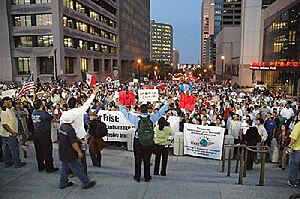2006 United States immigration reform protests
| 2006 United States immigration reform protests | |
|---|---|

Thousands gather in favor of immigrants' rights in Nashville, Tennessee on March 29, 2006
|
|
| Date | March - May |
In 2006/07, millions of people participated in protests over a proposed change to U.S. immigration policy. These large scale mobilizations are widely seen as a historic turn point in Latina/o politics, especially Latina/o immigrant civic participation and political influence, as noted in a range of scholarly publications in this field. The protests began in response to proposed legislation known as H.R. 4437, which would raise penalties for illegal immigration and classify undocumented immigrants and anyone who helped them enter or remain in the US as felons. As part of the wider immigration debate, most of the protests not only sought a rejection of this bill, but also a comprehensive reform of the country's immigration laws that included a path to citizenship for all undocumented immigrants.
The 2006 immigration protests were a series of demonstrations that began in Chicago and continued throughout major cities nationwide for a period of eight weeks. A major demonstration in Chicago on March 10, 2006 estimated at 100,000 people was the initial impetus for protests throughout the country. The largest single demonstration occurred in Los Angeles on March 25, 2006 with a march of more than 500,000 people through downtown. The largest nationwide day of protest occurred on April 10, 2006, in 102 cities across the country, with 350,000–500,000 in Dallas. Most of the protests were peaceful and attracted considerable media attention. Additional protests took place on May Day.
The marches reached a climax on May 1, 2006 and were nicknamed "A day without Immigrants" after the film A Day Without a Mexican. Naming the protests in such way encouraged immigrants to quit their daily labor-intensive jobs for a day to draw attention to their significant contributions to U.S. daily life. Latina/o immigrants across the country were urged to boycott work, school and other economic activities. Those outside the Latina/o community were shocked to see the growing workforce of janitors, nannies, restaurant workers and many other service workers leave their underrepresented and under appreciated jobs to join the protests. The mobilization of working-class undocumented immigrants challenged the belief that the United States would be able to prosper without undocumented immigrants.
The protests took place on May 1, a date meant to honor workers throughout the country. The May 1st marches reflected the immigrant protesters’ identities as workers and significant contributors to U.S. society. Most immigrants of Latin American descent come to the United States seeking economic prosperity for themselves and their families, they infrequently accept low wage jobs to survive in the United States. Therefore, missing work for a day burdened their families. Yet, thousands of immigrants risked their jobs and joined the marches to demand political recognition.
...
Wikipedia
